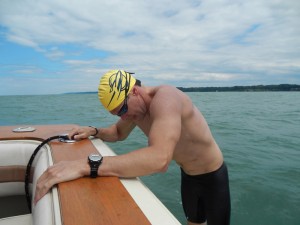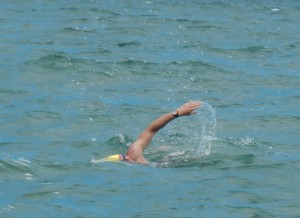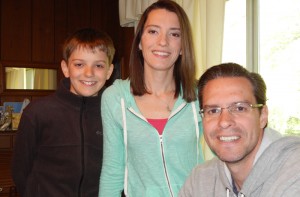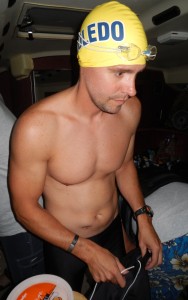Swimming for his Life
by Patty Gelb
 Standing on the Canadian bank of Lake Erie looking across its black waters, contemplating his pending 24-mile swim at midnight, Ryan Stevens (B.A. in English ’95) felt a bit nervous. The view looked very different than when he was looking at the water from the American side earlier in the afternoon. Earlier the sun was out, the water was calm and he could see the lighthouse across the lake. But, Lake Erie has a funny way of letting a swimmer know when she is ready for you to swim across her. For Stevens, she decided his chance was at midnight.
Standing on the Canadian bank of Lake Erie looking across its black waters, contemplating his pending 24-mile swim at midnight, Ryan Stevens (B.A. in English ’95) felt a bit nervous. The view looked very different than when he was looking at the water from the American side earlier in the afternoon. Earlier the sun was out, the water was calm and he could see the lighthouse across the lake. But, Lake Erie has a funny way of letting a swimmer know when she is ready for you to swim across her. For Stevens, she decided his chance was at midnight.
This swim across Lake Erie was never supposed to happen at night. But the Monroe, Mich., native who was diagnosed with Crohn’s disease in 2009, had been through hell and back getting to this moment. He planned this swim across Lake Erie to help raise awareness of a disease which may affect as many as 700,000 Americans. Originally it was scheduled to happen during the day, in the sun, with hopefully calm waters. Unfortunately, weather issues had narrowed his window of opportunity to this night in mid-July. Even though he was a little nervous about swimming at night, he had trained for months. He wasn’t going to back down from his chance. So he faced the black waters and started to swim.
There was a time a few years earlier that Stevens couldn’t imagine attempting a lengthy swim across the open waters of Lake Erie. He couldn’t even get off of the couch. It all began Christmas morning in 2008. He woke up feeling rotten and thought that he had food poisoning. Days later, still feeling sick, Stevens’ wife Samantha pushed him to go to the doctor.
At that first appointment the doctor told him he probably had food poisoning or something upset his stomach. He was told to eat yogurt and if not better in a week to come back. A week later, Stevens was still feeling the symptoms similar to food poisoning. He was referred to a gastroenterologist. It was over a month before that appointment all the while dealing with significant pain, daily fevers, severe diarrhea and serious weight loss.
At that appointment on March 2, 2009, Stevens had his first colonoscopy and at the age of 35 was diagnosed with Crohn’s disease. Named after Dr. Burrill Crohn, who first described the disease in 1932, Crohn’s disease belongs to a group of conditions known as inflammatory bowel diseases. Crohn’s disease is a chronic inflammatory condition of the gastrointestinal tract. The disease causes the immune system to attack healthy tissues in the intestines which leads to symptoms like bleeding, diarrhea, stomach pain and weight loss.
Over the next year and a half, Stevens, who works for a company that translates foreign languages, was put on a variety of different medications to try to alleviate his symptoms but nothing ended up helping. At one point his doctor started throwing around the word “surgery,” which scared Stevens. He kept pushing to try different medications. By October of 2010 he had another colonoscopy and he was told that they really needed to consider surgery. Stevens went for a second opinion at the Cleveland Clinic.
At first the doctors at the Cleveland Clinic changed his medications and gave those changes a few months to see if there was improvement. There was not. Ryan still was fatigued, sick, losing weight and unable to do much of anything but sleep or lay on the couch. In February, 2011, he lost another 11 pounds in just a week and a half. When he went back to the doctor, he was immediately admitted into the hospital. The next day they did a full colonoscopy and following those results, his doctor told him that he really should not leave the hospital until he had surgery to remove his colon.
Although he had been fighting to not have to have surgery, he realized that he had spent the last two years subsisting between his couch, the bathroom and his bedroom. His life had been on hold for that full two years. He missed weddings of his best friend and several family members.
“When you have to consider even a 15-minute drive somewhere, knowing that you will need a bathroom within five minutes, your life becomes a little more complicated,” said Stevens.
Also, because his body was not accepting nutrients he was experiencing severe weight loss. He was constantly fatigued and weak. Stevens was exhausted all of the time over those last two years.
He recalled, “I would just look down at the ground and decide this looks like a very good place to take a nap.”
He would lay down on the floor right where he was and fall asleep not having the strength to go into the bedroom and lay down on the bed. One time his wife came home to find him passed out on the floor in the middle of the room.
“She just freaked out because she thought I was unconscious or that something happened. I woke up to her screaming and shaking me,” he remembered. He looked up and told her that he just wanted to take a nap. His wife told him to never do that to her again.
But the hardest part for Stevens was what it did to his relationships, especially between him and his now 12-year-old son Riley. They had always been an active family until this disease.
“I remembered Riley running in every day to ask ‘Hey dad, let’s go out and…’ asking different things that we could go do together,” Stevens said. “I shouldn’t have done it, but I would always say to him, ‘Not today buddy, maybe tomorrow.’ It came to the day where Riley just stopped asking because he already knew what the answer was going to be.”
Stevens was tired. Normally weighing a little over 180 pounds, he weighed 120 at that point. He was so underweight that his medical team discussed potentially putting him on a feeding tube to gain back some weight before surgery. But they determined that they needed to proceed. When he was told they should go ahead with the surgery he agreed.
When he met his surgeon, he liked her immediately. She came into his room, sat down, took his hand and said, “So it sounds like you aren’t feeling well.” That made Stevens and his wife chuckle and put them at ease. His surgeon told him that they were going to go in, remove his colon and he was going to bounce back so quickly, that he would kick himself for not doing this a year ago. He hoped that was the case and it turned out that it was. He had the surgery and the first week home, he gained 11 pounds. He felt great!
“I credit my wife with keeping me alive because I am such a stubborn guy, especially about going to doctors,” said Stevens. “She is the one who pushed me to go originally and kept me on track.”
 A full year following all of his surgeries, Stevens was still feeling wonderful. He was continuing to gain weight and working to get back into shape. One of his doctor’s instructions was to work out because that helps stimulate the immune system. Stevens was a competitive swimmer all the way through high school and college, even competing on the swim team at UT. Coming from a swimming background, his natural inclination when instructed to work out was to get back in the pool.
A full year following all of his surgeries, Stevens was still feeling wonderful. He was continuing to gain weight and working to get back into shape. One of his doctor’s instructions was to work out because that helps stimulate the immune system. Stevens was a competitive swimmer all the way through high school and college, even competing on the swim team at UT. Coming from a swimming background, his natural inclination when instructed to work out was to get back in the pool.
He also really wanted to write about what he had been through with Crohn’s disease so he started a blog (link to the blog below).
“When I was going through it, I was too close to it,” Stevens said. “I couldn’t wrap my brain around it. But now, I really want to talk to others who were dealing with Crohn’s. I also wanted to educate people about this disease.”
He takes a very humorous approach to it. Go the blog to see his Jabba the Hut with Crohn’s reference.
 When he was creating his blog, he also wondered how he could create more awareness of the disease. Since he was back swimming regularly again, his first thought was he could swim the English Channel. But after research, he found that the costs were prohibitive. He then thought “Hey, I live in a Great Lakes’ state” so he started researching swimming the lake. He found Dr. Eric Mizuba of Erie, Pa., who made the crossing in July, 2012 and reached out to him for advice.
When he was creating his blog, he also wondered how he could create more awareness of the disease. Since he was back swimming regularly again, his first thought was he could swim the English Channel. But after research, he found that the costs were prohibitive. He then thought “Hey, I live in a Great Lakes’ state” so he started researching swimming the lake. He found Dr. Eric Mizuba of Erie, Pa., who made the crossing in July, 2012 and reached out to him for advice.
“He was very helpful to me and I now call him my coach,” Stevens said. “He was instrumental in giving me all of the information that I needed to plan and train for this venture.”
Training involved a lot of boring laps in the pool. With such a cool and rainy spring, most of his training time was in the pool doing sets and interval training. This is very different than training in the lake where he could experience dealing with waves, wind and current.
“In a pool you have a black line on the bottom of the pool that says stay here,” Stevens said. “You don’t have that in the open water which is one of many challenges of swimming in the lake. But, I actually feel comfortable in the open water. I generally will have one wave hit me early on which makes me swallow lake water. Then I say, ‘That isn’t going to happen again.’ I adapt pretty quickly.”
The swim across the 24-mile stretch of Lake Erie was planned and promoted. He had the weekend set and was ready to go either Saturday or Sunday. He had been told by both Mizuba and his boat captain that you don’t really pick the day; you let the lake tell you the day. But, when the team got down to the marina the Friday before his planned weekend, the captain said there is no way he could do it Saturday or Sunday. It was forecasted to rain with lighting and high winds.
The boat captain then asked him about swimming in the dark and if he wanted to attempt the swim that night.
Stevens joked, “I know I only have half of my guts left and that half at first said, ‘I don’t know about this.’”
It was a tough decision and it took him about twenty minutes to make up his mind. It was already July and knowing the rest of his family’s summer schedule, this was his only chance left this season. He finally decided and told the team “Ok, let’s do this.”
 Stevens’ team consisted of his wife, his son, his two brothers and a couple of his friends. As they were loading the boat and getting the equipment ready late that afternoon, the weather was perfect. But by the time everything was loaded and ready to go, it was dark out.
Stevens’ team consisted of his wife, his son, his two brothers and a couple of his friends. As they were loading the boat and getting the equipment ready late that afternoon, the weather was perfect. But by the time everything was loaded and ready to go, it was dark out.
As they were preparing to start the swim from the Canadian bank of the lake, Stevens realized another obstacle that he hadn’t planned for. He regularly wears glasses and swims with prescription goggles. But, his prescription goggles are tinted making an already black night even darker. He would have to wear non-prescription goggles which would only let him see a little light but everything would be blurry.
When he jumped into the water, it was 12:18 a.m. on Saturday.
“I am blind as a bat without my prescription goggles, let alone with it being at night,” Stevens said. “To help me see, they hung glow sticks off of the side of the kayak that ran a couple of yards away from me. I breathe to the right so when I would turn my head, all I could see would be two tiny and blurry lights as a guide.”
The water wasn’t perfectly calm, but not too bad at the start. The two things that affected Stevens the most were the cold and the thought of debris in the water. There had been storms during the week, leaving obstacles in his path. While swimming, Stevens could see his hand when it passed his face but it would totally disappear into the darkness before it even hit the water. There was no way that he would see a piece of driftwood before running full speed into it. That kept his mind working not letting him get into that “Zen-like” state that he normally gets into while swimming distance.
The whole time he was in the water, the weather kept getting worse. A southerly wind was coming in from Pennsylvania right into their path which was kicking up the waves and current.
But it was the cold that really affected him. The water temperature was 73 degrees, which he said wasn’t too bad when he was moving. But, when he would stop for drinks or food, the chill crept in. It was during his third break, at 5.7 miles, when Stevens came out of the water.
“I really needed the sun,” he said. “Two weeks prior to the swim, I went out to meet the captain and make final arrangements. We went out on the lake and I swam for a while. That day the sun was out and it was warming my back and it made all of the difference in the world.”
The disappointment he felt was tempered by an incredible team of supporters who dove in head first.
The plan had always been that if Stevens was unable to complete the swim that the team would turn it into a relay for Crohn’s disease. When the UT alumnus got out, his good friend Chris got in and started swimming. The replacement swam two miles before the team had to pull him in back in the boat. At that point they were hitting six to seven foot rolling waves. The forecast showed no sign of improvement. The rest of the swim was called off…at least for this year.
“So we gave it a try and I am absolutely not giving up,” said Stevens. “I will swim across that lake. It was disappointing to not make it the first time but we learned a lot. The biggest thing that I learned was I don’t pick the day. The lake picks the day. I need to go back with a window of a week or maybe even longer and be ready to go on the day that is the right day weather-wise. The forecast for the night that we did the swim was supposed to be calm, but it changes on a dime.”
Stevens knew that he did not want Crohn’s to slow him down anymore. As he says, he may have a chronic condition but the idea is to overcome it. He learned that there were a lot of people who have Crohn’s and going through a lot of what he went through. He got a lot of emails from others thanking him for doing the swim to help raise awareness of the disease. Stevens just really wanted to try to make a difference.
 “Crohn’s is a real nasty beast,” he said. “It comes in and takes over your life. I feel it is important to discuss this disease because it can be an invisible illness. You can look at me now and think that I look healthy, but if you looked at my insides you would know otherwise. When I was down to 120 pounds I could have walked onto the set of “Walking Dead” and the director would have grabbed me and put me right in the front of the shot because I looked the part even without the zombie makeup.”
“Crohn’s is a real nasty beast,” he said. “It comes in and takes over your life. I feel it is important to discuss this disease because it can be an invisible illness. You can look at me now and think that I look healthy, but if you looked at my insides you would know otherwise. When I was down to 120 pounds I could have walked onto the set of “Walking Dead” and the director would have grabbed me and put me right in the front of the shot because I looked the part even without the zombie makeup.”
Crohn’s disease does not have a cure. Stevens hopes that there are kids out there that are interested in science and math to become the scientists who will come up with the cure.
“Over 70 percent of our immune system is located in our gut,” said Stevens. “If we had a cure for Crohn’s, we would have a cure for many other things. I can’t prove that but that is my wishful thinking anyway and I believe that is something to focus on.”
To learn more about Crohn’s disease, you can visit The Crohn’s Colitis Foundation of America’s website by clicking here.
To read more about Ryan Stevens’ experiences, visit his blog by clicking here.






